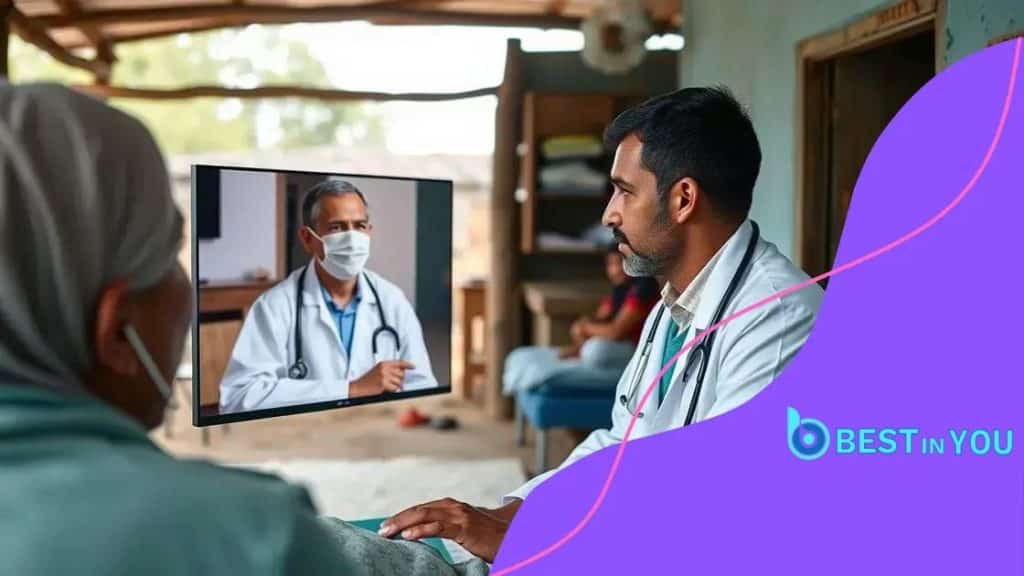The impact of telemedicine expansion on rural healthcare

Advertisements
The impact of telemedicine expansion on rural healthcare includes improved access to medical services, reduced travel time, and increased patient engagement through technology and virtual consultations.
The impact of telemedicine expansion on rural healthcare is significant, changing how patients connect with providers. Ever thought about how this could affect your healthcare access in remote areas?
Anúncios
Understanding telemedicine and its growth
Understanding telemedicine is crucial as it becomes a significant part of modern healthcare. This technology allows healthcare providers to offer services remotely, making it easier for patients to access care from home.
Telemedicine is growing rapidly due to advances in technology and changing patient needs. Many factors contribute to this expansion, including the increasing availability of high-speed internet and greater acceptance of virtual consultations.
Key benefits of telemedicine
One of the main advantages of telemedicine is that it provides better access to healthcare, especially in rural areas. Patients in remote locations can connect with specialists without traveling long distances. Additionally, it offers convenience and can reduce waiting times for appointments.
Anúncios
- Improved access to care
- Convenience for patients
- Lower healthcare costs
- Continuity of care during emergencies
Another factor driving the growth of telemedicine is the COVID-19 pandemic. Many patients turned to virtual care during this time, leading to increased comfort and familiarity with telehealth solutions. As a result, regulations and reimbursement policies have evolved, making it easier for healthcare providers to offer these services.
Furthermore, technological advancements are paving the way for innovative solutions, such as remote patient monitoring and mobile health apps. These tools offer personalized care and allow patients to track their health conditions from the comfort of their homes.
Challenges to consider
Despite its advantages, telemedicine does face some challenges. Issues like internet accessibility, particularly in underserved areas, can hinder its effectiveness. Moreover, not all patients are comfortable using technology, which may create barriers to care.
- Internet accessibility issues
- Patient technology comfort
- Regulatory hurdles
- Data privacy concerns
As we continue to embrace this technological era, understanding telemedicine and its growth is essential in enhancing healthcare delivery for all.
Benefits of telemedicine for rural communities
The benefits of telemedicine for rural communities are vast and impactful. By utilizing technology, patients in remote areas can access quality healthcare that was previously hard to obtain. This accessibility is transforming the way health services are delivered and received.
One significant advantage is that telemedicine reduces travel time for patients. In rural regions, going to a healthcare facility can mean long hours on the road. Telemedicine eliminates this need, allowing patients to consult with doctors from their homes.
Enhanced healthcare access
Additionally, telemedicine enhances access to specialists. Often, rural communities lack specific medical professionals. Through virtual consultations, local patients can connect with specialists in urban centers without needing to travel.
- Increased availability of healthcare specialists
- Timely consultations for urgent health issues
- Preventative care through regular follow-ups
- Improved health outcomes for chronic conditions
Another benefit is the flexibility it offers for scheduling appointments. Patients can arrange consultations around their work and family commitments, leading to higher rates of attendance and patient satisfaction.
Telemedicine also plays a role in reducing healthcare costs. By avoiding expensive travel and taking fewer days off work, patients save money. The overall healthcare system may also see savings due to fewer emergency room visits as patients receive timely care through remote consultations.
Convenience and comfort
Convenience is another reason why telemedicine is so beneficial. Patients can receive care in a comfortable environment. This setting can make discussing health problems easier, especially sensitive issues. Many people feel more relaxed discussing their health from home.
- Comfortable and private consultation environment
- Reduced anxiety related to hospital visits
- Increased engagement in personal health management
- Greater adherence to treatment plans
In summary, telemedicine is a game changer for rural healthcare. By improving access, enhancing convenience, and reducing costs, it paves the way for better health outcomes in communities that need it most.
Challenges faced in telemedicine adoption

The challenges faced in telemedicine adoption are complex and can vary widely. While telemedicine offers many benefits, some obstacles must be addressed for it to be fully integrated into healthcare systems.
One major challenge is internet accessibility. In rural areas, where many potential telemedicine users live, reliable internet service might be limited or nonexistent. This lack of connectivity can prevent patients from accessing necessary healthcare resources.
Technological barriers
Technological literacy is another hurdle. Not all patients are comfortable using technology, and some may struggle with the necessary devices or applications. Training may be needed to help patients navigate these platforms effectively.
- Difficulty in understanding software
- Lack of devices for remote consultations
- Need for ongoing technical support
- Willingness to adopt new technology
Data privacy is a significant concern as well. Patients want assurance that their medical information remains confidential and secure. Misuse or breaches of sensitive data can lead to mistrust in telemedicine services.
Another detrimental factor is the regulatory landscape. Policies surrounding telemedicine are still evolving, which can create confusion. Variations in state laws regarding licensing and reimbursement can limit providers from offering services across state lines.
Economic considerations
The cost of implementing telemedicine services can also deter healthcare providers from adopting this technology. For some facilities, investing in the necessary infrastructure, such as software and hardware, may be a significant financial burden.
- High initial setup costs
- Investment in staff training
- Maintaining updated technology
- Insurance reimbursement challenges
Additionally, the perception of effectiveness can be a barrier. Some healthcare professionals may believe that in-person consultations are superior to virtual visits, which can influence their willingness to adopt telemedicine practices.
Telemedicine technologies reshaping healthcare
Telemedicine technologies are reshaping healthcare in exciting ways. These innovations improve how patients access care and how providers deliver services. Remote consultations, electronic health records, and mobile health applications are just a few advancements making a difference.
One key technology is video conferencing. This tool allows healthcare providers to meet with patients face-to-face, even when miles apart. Video calls help maintain the personal touch while providing flexibility for both sides.
Wearable devices
Wearable devices, such as fitness trackers and smartwatches, are also changing telemedicine. These gadgets can monitor vital signs and send data to healthcare providers in real-time. This capability allows for better management of chronic diseases and more personalized care plans.
- Continuous heart rate monitoring
- Tracking physical activity levels
- Alerts for critical health changes
- Increased patient engagement
Mobile health applications have made healthcare more accessible. Patients can book appointments, receive reminders, and access medical records on their smartphones. This convenience encourages patients to take a more active role in their healthcare management.
Artificial Intelligence advancements
Artificial intelligence (AI) is another game changer. AI can analyze patient data to identify patterns and predict health outcomes. This technology can lead to earlier interventions and better health management.
- Predictive analytics for disease prevention
- Streamlined administrative processes
- Enhanced diagnostic tools
- Personalized treatment recommendations
Telemedicine technologies are also making healthcare more efficient. Electronic health records reduce paperwork and streamline information sharing among providers. This leads to faster diagnoses and treatments, benefiting both patients and healthcare systems.
Future prospects of telemedicine in rural areas
The future prospects of telemedicine in rural areas appear bright as advancements continue to bridge the gap in healthcare access. With technology evolving rapidly, rural communities can expect improved health services tailored to their needs.
One promising trend is the increased investment in high-speed internet infrastructure. As more areas gain reliable connectivity, the potential for telemedicine to enhance healthcare becomes even more significant. This expansion of internet access could support various telehealth services, from virtual visits to remote monitoring.
Greater integration of technology
As telemedicine technologies evolve, we can anticipate the integration of artificial intelligence (AI) and machine learning into healthcare practices. These advancements can lead to more accurate diagnoses and personalized treatment plans. AI tools could analyze patient data to predict health risks, allowing providers to intervene early.
- Personalized patient care through analytics
- Improved diagnostic accuracy
- Streamlined healthcare workflows
- Support for clinical decision-making
Another aspect of the future of telemedicine involves expanding services to mental health care. Accessing counselors and therapists through telehealth can be especially beneficial for individuals in remote areas who may face stigma or travel barriers when seeking support.
Enhanced patient engagement
Consumer engagement is likely to increase as patients become more familiar with telehealth platforms. Healthcare providers may develop user-friendly applications to facilitate patient communication and education. This could empower patients to take charge of their health journeys and adhere to treatment plans more effectively.
- Improved patient education resources
- Greater involvement in health management
- Access to real-time health information
- Personalized health reminders
Additionally, as public acceptance of telemedicine grows, health insurance providers may expand coverage for telehealth services. This could make virtual care more affordable and accessible, allowing more patients to take advantage of these innovative solutions.
FAQ – Frequently Asked Questions About Telemedicine in Rural Healthcare
What are the main benefits of telemedicine for rural communities?
Telemedicine improves access to healthcare, reduces travel time, and allows patients to connect with specialists without leaving their homes.
What technologies are used in telemedicine?
Telemedicine relies on video conferencing, wearable devices, mobile health apps, and AI to provide quality care remotely.
How can telemedicine improve patient engagement?
Telemedicine encourages patient engagement through user-friendly apps that allow patients to manage appointments and access health information easily.
What challenges does telemedicine face in rural areas?
Challenges include limited internet access, technological literacy among patients, data privacy concerns, and regulatory issues.





